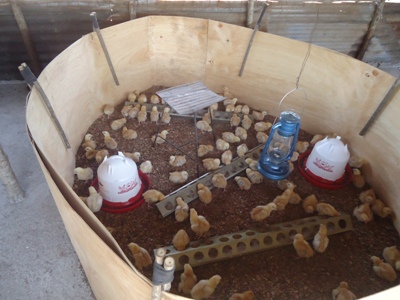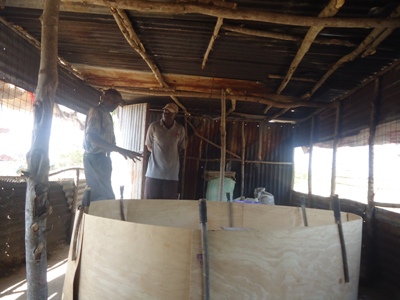Temperature
The body temperature of a day-old chick is approximately 390 C, but by the fifth day of age the body temperature rises to 41.10 C, which is the normal body temperature of an adult bird.
Chicks require heat from the time they are hatched until they are six weeks old because they cannot maintain their body temperature without an external source. The ability to regulate body temperature is acquired around 12 to 14 days of age.
While chicks are more tolerant to high temperatures than adult birds, high temperatures for extended periods of time increase mortality and have negative impact on performance. Chicks that are subjected to cold temperature have impaired immune and digestive systems which result in reduced growth and increased susceptibility to diseases.
Warm the brooding area before the chicks arrive.Chicks can be easily stressed if their body temperature decreases or increases by as much as one degree. During the first week temperatures should be 320 to 350 C then reduced by 2.50 C per week until room temperature is reached. The actions of the chicks can be a guide in temperature control. Read how to control temperature in a brooder.

Floor temperatures are also crucial. The average floor temperatures should be 320C on the day that chicks are placed in the house.
Ventilation
Good ventilation is required to control temperature and get rid of carbon dioxide, ammonia, other gases, moisture, dust and odors. Air entering the brooding house should be warmed up to brooding temperature before coming into contact with the chicks to prevent chilling. This also increases moisture holding capacity thereby helping to maintain litter conditions in the house.
In large brooding houses fans should be used to break up temperature stratification and provide a more uniform temperature throughout the poultry house.
Humidity
The level of humidity influences the ability of the bird to cool itself through panting and influences ammonia production. Relative humidity should be maintained between 50 and 70 percent during the brooding period. Dusty conditions in the poultry house are associated with relative humidity below 50 percent. If relative humidity increases above 70 percent ammonia from the birds fecal material accumulates and has a negative impact on bird health and performance. High ammonia levels impair the immune system, increases respiratory diseases and reduces growth rate which is never gained back.
Lighting
The main purpose of lighting during brooding is to ensure that chicks are active and seek out food and water sources. Chick activity is higher in bright than in low light intensity. Bright lights assist chicks to locate feed and water and this is usually accomplished by 7 to 10 days of age. Thereafter the light intensity and duration should be reduced to a minimum of 25 lux (2.5 foot candles) or more at bird level. Normally lights are initially allowed 23 hours a day at maximum intensity. Then the intensity is reduced when chicks are 7 to 10 days of age and by 10 to 14 days it should be at 5 lux (0.5 foot candles).
Housing

Inside a local brooding house
Some people brood their chicks in their homes but this is not recommended. Brooders present a certain amount of fire risk so a high degree of precaution should be taken when deciding its location and design.
Brooder houses generally have litter floors, preferably with a layer of wood shavings at least four inches thick. Brooders with wire floors and a droppings pan underneath can also be used but they smell worse than the other kinds of brooders.
The brooding house should be clean, dry and comfortable with adequate heat and space. The equipment should be clean and in good condition. The location should be draft-free with good air circulation, access to clean water and be well protected.
A brooder house measuring 10 by 12 feet accommodates 120 chicks to the age of eight weeks. Chick guard rings should be 12 inches high arranged in a circle 6 feet in diameter around the brooder stove. Feeders are placed in a spoke-like arrangement radiating outward from underneath the outer portion of the brooder canopy. This provides chicks access to feed and allows them to move freely in and out from the heat source.
| Age of chicks | Floor space per bird |
| 0 to 4 weeks | 1/2 square foot |
| 4 to 8 weeks | 1 square foot |
Water
Chicks should have warm water available right way. Waterers should be placed on a block to keep the water free from litter. Replace the water twice a day, or more frequently if necessary to keep the water clean and fresh. Clean the waterer each time you make the change, and refill it with lukewarm water.
The amount of waterer space recommended for 100 brooding chicks is:
| Age of chicks | Waterer space |
| 0 to 1 week | Six 1-quart jar waterers |
| 1 to 4 weeks | Two 2-gallon waterers |
| 4 to 12 weeks | Two 5-gallon waterers |
Automatic waterers may be used after the first week. Many types of waterers are available from local agrovets. Note that in the first few days chicks can get soaked in waterers with wide bowls and may die of chilling. So use small waterers at first and gradually replace with regular ones.
Feeding
Provide feed and water as soon as the chicks are transferred to the brooder. If possible the chicks should be fed about three hours after being introduced into the brooder. Also they tend to be dehydrated and it is important that they drink the water first before they eat.
Give the first feed on flat surfaces at ground level. One square foot per 50 chicks is a good spacing. Set up the regular feeders and fill them right from the beginning.
Rapidly growing chicks should have a well-balanced starter diet for proper growth and development. For the first two days, it is a good idea to feed the chicks on cracked maize grains to reduce the problem of dried feces attaching on the rear. Thereafter replace the cracked maize grains with a chick starter mash.This can be done by feeding grain in the first feeders and chick starter in the regular feeders.
The feeder space recommended for 100 chicks is:
| Age of chicks | Feeder space |
| 0 to 4 weeks | 12 linear feet or two 3-foot feeders |
| 4 to 8 weeks | 20 linear feet or two 5-foot feeders |
Types of Brooders
Some types of brooders heat the entire room or house. Other types warm the area under or near the hover, while the rest of the room remains relatively cool. The most popular brooders are infrared heat lamps, propane gas brooders and propane catalytic brooders. Convenience, installation cost and operating cost will determine the choice.
The infrared heat lamp (Pyrex-type) is ideal for brooding small lots of 200 chicks or less. One 250-watt lamp is provided for each 50 to 75 chicks. During normal weather, infrared heat lamps placed 1 to 1.5 feet above the chicks will usually provide enough heat.
Large commercial poultry operations generally use big propane brooders with a central brooder and a metal canopy or hover that retains the heat. Each brooder handles 1,000 or more chicks.
Farmers brooding fewer than 1,000 chicks at once generally use electric brooders.
Preventing coccidiosis
Coccidiosis can take a heavy toll on chicks, starting from about three weeks of age. Chicks raised on litter floors become infected easily and the multiplication of the bacteria can lead to dead, stunted, and sick chicks. Chicks that are exposed to only low levels of coccidia become immune without becoming sick.
A lot of people don’t like the idea of using medicated feed but that is the only way of treating the disease. If you want to mix your own feed, you will need to use coccidiostats to control the disease. Almost all commercial poultry feeds contain drugs that suppress coccidia.
Treating Coccidiosis
Anti-coccidial drugs are very effective. Infected chicks should be treated immediately by putting a coccidiostat in the water. Drug substitutes such as garlic and herbs are not as effective as drugs.








